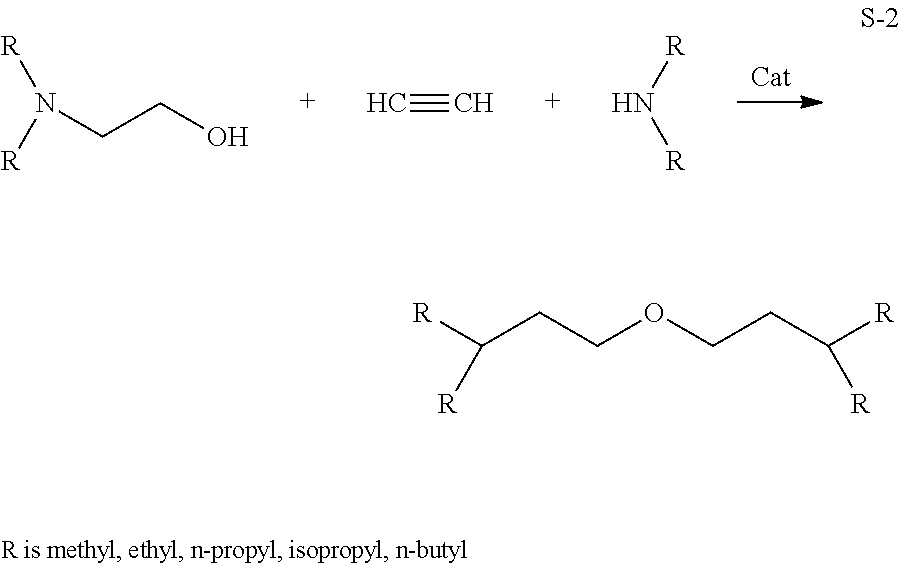Method for Preparation of Bis (2-dialkyaminoethyl) Ether
a technology of dimethyl ether and ether, which is applied in the preparation of amino-hyroxy compounds, organic chemistry, organic compound preparations, etc., can solve the problems of weak corrosion of reaction environment, trivial way of feeding sulfur trioxide, and defects of original methods, etc., and achieves high atomic economy
- Summary
- Abstract
- Description
- Claims
- Application Information
AI Technical Summary
Benefits of technology
Problems solved by technology
Method used
Image
Examples
example 1
[0037] a bis (2-dimethylaminoethyl) ether synthesizing method using N,N-dimethylethanolamine, dimethylamine and ethyne as raw materials (original raw materials) is performed by the following operations in proper order:
[0038]step 1: synthesizing:
[0039]wherein at a room temperature, 89 g N,N-dimethylethanolamine (1.0 mol), 124.5 g dinbutyl ether (as a solvent) and 8.7 g potassium hydroxide are added in a high-pressure reaction clave with a mixing and temperature-measuring device; and the clave cover is put on and leakage is inspected, then 13 g ethyne (0.5 mol) and 22.5 g dimethylamine (0.5 mol) are forced into the clave in proper order; after feeding, a temperature is raised to 100° C. and kept on for 5 h before the reaction ends;
[0040]after reaction, the clave is opened and a filtrate is obtained by filtering the reaction mixtures; and
[0041]step 2: separating:
[0042]wherein the filtrate obtained is then distilled at 40° C. and atmospheric pressure for half an hour and unreacted dimet...
example 2
[0044] a bis (2-diethylaminoethyl) ether synthesizing method using N,N-diethylethanolamine, diethylamine and ethyne as raw materials (original raw materials) is performed by the following steps in proper order:
[0045]step 1: synthesizing:
[0046]wherein at a room temperature, 117 g N,N-diethylethanolamine (1.0 mol), 268 g diisobutyl ether (as a solvent) and 3.6 g sodium ethoxide are added in a high-pressure reaction clave with a mixing and temperature-measuring device; the clave cover is put on and leakage is inspected; then 6.5 g ethyne (0.25 mol) and 55.0 g diethylamine (0.75 mol) are forced into the clave in proper order; after feeding, a temperature is raised to 50° C., and kept on for 7 h before completing the reaction;
[0047]after reaction, the clave is opened and a filtrate is obtained by filtering the reaction mixture; and step 2:
[0048]distilling the filtrate obtained at 60° C. and atmospheric pressure for half an hour for the unreacted diethylamine to come out; then proceeding ...
example 3
[0049] a bis (2-dinpropylaminoethyl) ether synthetic method using N,N-dinpropylethanolamine, dinpropylamine and ethyne raw materials (original raw materials) to perform the following steps in proper order:
[0050]step 1:
[0051]at a room temperature, adding 145 g N,N-dinpropylethanolamine (1.0 mol), 508 g 1,3-dioxolane (as solvent) and 25.4 g sodium hydroxide in a high-pressure reaction clave with a mixing and temperature-measuring device; putting the clave cover on and inspect leakage; forcing in 8.7 g ethyne (0.33 mol) and 101 g dinpropylamine (1.0 mol) in a proper order; after feeding, raising a temperature to 120° C.; holding the above reaction temperature and reacting for 3 h before completing the reaction;
[0052]opening the clave after reaction and filter; collecting a filtrate obtained; and
[0053]step 2:
[0054]for the filtrate obtained at a pressure of 1 kPa, collecting previous fractions (all fractions before 180° C.)—unreacted dinpropylamine, N,N-dinpropylethanolamine and solvent;...
PUM
| Property | Measurement | Unit |
|---|---|---|
| temperature | aaaaa | aaaaa |
| mass ratio | aaaaa | aaaaa |
| temperature | aaaaa | aaaaa |
Abstract
Description
Claims
Application Information
 Login to View More
Login to View More - R&D
- Intellectual Property
- Life Sciences
- Materials
- Tech Scout
- Unparalleled Data Quality
- Higher Quality Content
- 60% Fewer Hallucinations
Browse by: Latest US Patents, China's latest patents, Technical Efficacy Thesaurus, Application Domain, Technology Topic, Popular Technical Reports.
© 2025 PatSnap. All rights reserved.Legal|Privacy policy|Modern Slavery Act Transparency Statement|Sitemap|About US| Contact US: help@patsnap.com


